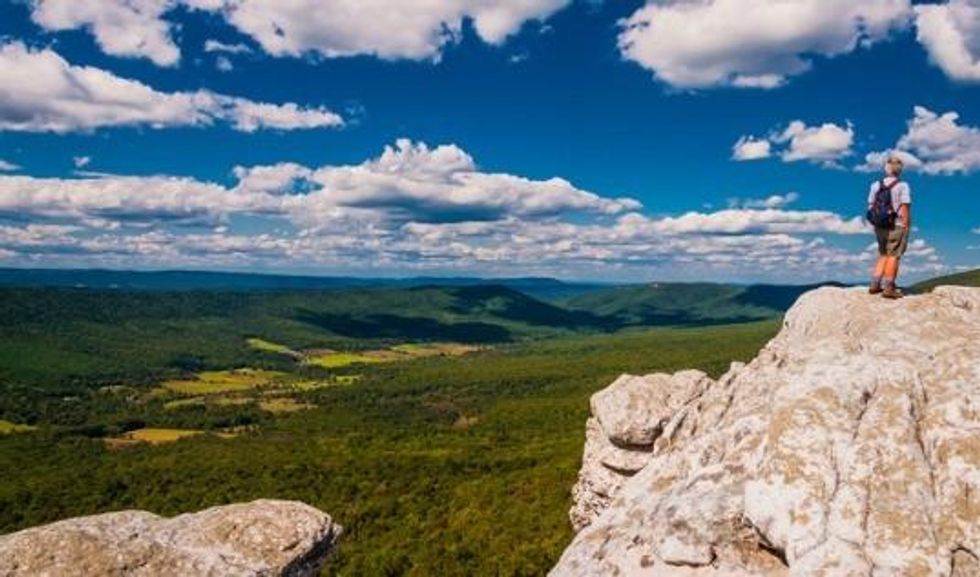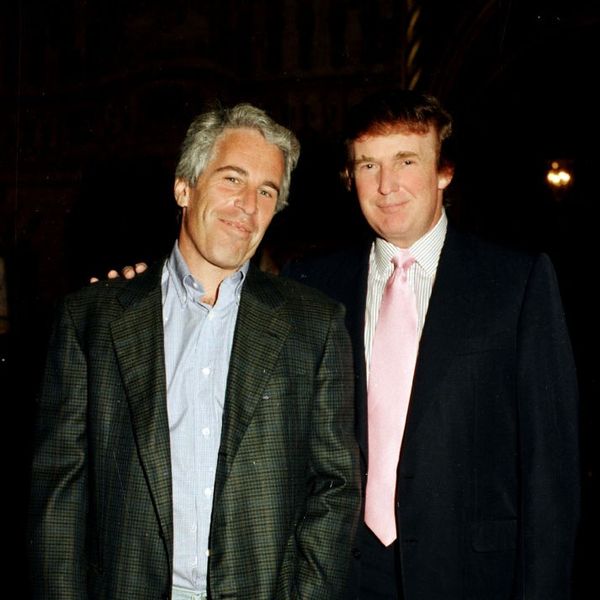Will the US Open a National Forest to Fracking?
Proposed fracking in George Washington National Forest puts 4.5 million people at risk of water contamination, critics say

An original draft plan for the forest preserve, released by the Forest Service in 2011, included a ban on fracking that spawned "an outcry from industry." That outcry pushed the Forest Service to reconsider. A final decision on the ban has now been delayed several times as the industry has continued pressure on the agency.
However, as the Los Angeles Times reports, the potential risk has "drawn widespread opposition, including from most of the towns and counties nearby, members of Virginia's congressional delegation and Washington's mayor."
In total, roughly about 4.5 million people depend on the water from the park and could potentially face contamination if proposals to open the park to "high-volume hydraulic fracturing" goes through.
"The Potomac is our exclusive water source. We don't have anywhere else to go for our drinking water if there's a mistake or problem," said George Hawkins, general manager of the District of Columbia Water and Sewer Authority. "And if there is, it would affect everyone at the [Environmental Protection Agency], every member of Congress."
"One of the country's most popular national forests is absolutely the wrong place for drilling and fracking," states the Southern Environmental Law Center, which recently launched a campaign to protect the area from fracking.
Which way the U.S. Forest Service is leaning is yet to be seen. However, the agency currently permits fracking in the Dakota Prairie National Grasslands in North Dakota and Pawnee National Grassland in Colorado.
"Minerals have always been a part of what we've been about, but we have to weigh if it's appropriate to develop them in this forest with this set of conditions," said Ken Landgraf, planning staff officer for George Washington National Forest. "The 'why' of considering fracking gets to the use of national lands. If we are developing energy in this country and making it more secure, shouldn't national lands be part of the solution?"
If fracking is permitted, not only will water safety be a risk, but precarious, steep and narrow park roads will be consumed with industrial truck traffic, forest land will be cleared for pipelines, and hilltops would be flattened for compressor stations, Nancy Sorrells, a historian of the region and former Augusta County supervisor, told the Los Angeles Times.
The Los Angeles Times continues:
Sarah Francisco, one of the Southern Environmental Law Center attorneys...said the possibility of fracking in the forest raised unsettling questions: Would the gas companies compete with municipalities for the forest's water? Once it has been used in fracking, how would the highly contaminated water be disposed of, since local treatment plants could not handle it? Would methane from wells migrate into the water, as it has in parts of Pennsylvania? Would accidental spills of chemicals or waste-water taint the watershed?
______________________
An Urgent Message From Our Co-Founder
Dear Common Dreams reader, The U.S. is on a fast track to authoritarianism like nothing I've ever seen. Meanwhile, corporate news outlets are utterly capitulating to Trump, twisting their coverage to avoid drawing his ire while lining up to stuff cash in his pockets. That's why I believe that Common Dreams is doing the best and most consequential reporting that we've ever done. Our small but mighty team is a progressive reporting powerhouse, covering the news every day that the corporate media never will. Our mission has always been simple: To inform. To inspire. And to ignite change for the common good. Now here's the key piece that I want all our readers to understand: None of this would be possible without your financial support. That's not just some fundraising cliche. It's the absolute and literal truth. We don't accept corporate advertising and never will. We don't have a paywall because we don't think people should be blocked from critical news based on their ability to pay. Everything we do is funded by the donations of readers like you. Will you donate now to help power the nonprofit, independent reporting of Common Dreams? Thank you for being a vital member of our community. Together, we can keep independent journalism alive when it’s needed most. - Craig Brown, Co-founder |
Jacob Chamberlain is a former staff writer for Common Dreams. He is the author of Migrant Justice in the Age of Removal. His website is www.jacobpchamberlain.com.

An original draft plan for the forest preserve, released by the Forest Service in 2011, included a ban on fracking that spawned "an outcry from industry." That outcry pushed the Forest Service to reconsider. A final decision on the ban has now been delayed several times as the industry has continued pressure on the agency.
However, as the Los Angeles Times reports, the potential risk has "drawn widespread opposition, including from most of the towns and counties nearby, members of Virginia's congressional delegation and Washington's mayor."
In total, roughly about 4.5 million people depend on the water from the park and could potentially face contamination if proposals to open the park to "high-volume hydraulic fracturing" goes through.
"The Potomac is our exclusive water source. We don't have anywhere else to go for our drinking water if there's a mistake or problem," said George Hawkins, general manager of the District of Columbia Water and Sewer Authority. "And if there is, it would affect everyone at the [Environmental Protection Agency], every member of Congress."
"One of the country's most popular national forests is absolutely the wrong place for drilling and fracking," states the Southern Environmental Law Center, which recently launched a campaign to protect the area from fracking.
Which way the U.S. Forest Service is leaning is yet to be seen. However, the agency currently permits fracking in the Dakota Prairie National Grasslands in North Dakota and Pawnee National Grassland in Colorado.
"Minerals have always been a part of what we've been about, but we have to weigh if it's appropriate to develop them in this forest with this set of conditions," said Ken Landgraf, planning staff officer for George Washington National Forest. "The 'why' of considering fracking gets to the use of national lands. If we are developing energy in this country and making it more secure, shouldn't national lands be part of the solution?"
If fracking is permitted, not only will water safety be a risk, but precarious, steep and narrow park roads will be consumed with industrial truck traffic, forest land will be cleared for pipelines, and hilltops would be flattened for compressor stations, Nancy Sorrells, a historian of the region and former Augusta County supervisor, told the Los Angeles Times.
The Los Angeles Times continues:
Sarah Francisco, one of the Southern Environmental Law Center attorneys...said the possibility of fracking in the forest raised unsettling questions: Would the gas companies compete with municipalities for the forest's water? Once it has been used in fracking, how would the highly contaminated water be disposed of, since local treatment plants could not handle it? Would methane from wells migrate into the water, as it has in parts of Pennsylvania? Would accidental spills of chemicals or waste-water taint the watershed?
______________________
Jacob Chamberlain is a former staff writer for Common Dreams. He is the author of Migrant Justice in the Age of Removal. His website is www.jacobpchamberlain.com.

An original draft plan for the forest preserve, released by the Forest Service in 2011, included a ban on fracking that spawned "an outcry from industry." That outcry pushed the Forest Service to reconsider. A final decision on the ban has now been delayed several times as the industry has continued pressure on the agency.
However, as the Los Angeles Times reports, the potential risk has "drawn widespread opposition, including from most of the towns and counties nearby, members of Virginia's congressional delegation and Washington's mayor."
In total, roughly about 4.5 million people depend on the water from the park and could potentially face contamination if proposals to open the park to "high-volume hydraulic fracturing" goes through.
"The Potomac is our exclusive water source. We don't have anywhere else to go for our drinking water if there's a mistake or problem," said George Hawkins, general manager of the District of Columbia Water and Sewer Authority. "And if there is, it would affect everyone at the [Environmental Protection Agency], every member of Congress."
"One of the country's most popular national forests is absolutely the wrong place for drilling and fracking," states the Southern Environmental Law Center, which recently launched a campaign to protect the area from fracking.
Which way the U.S. Forest Service is leaning is yet to be seen. However, the agency currently permits fracking in the Dakota Prairie National Grasslands in North Dakota and Pawnee National Grassland in Colorado.
"Minerals have always been a part of what we've been about, but we have to weigh if it's appropriate to develop them in this forest with this set of conditions," said Ken Landgraf, planning staff officer for George Washington National Forest. "The 'why' of considering fracking gets to the use of national lands. If we are developing energy in this country and making it more secure, shouldn't national lands be part of the solution?"
If fracking is permitted, not only will water safety be a risk, but precarious, steep and narrow park roads will be consumed with industrial truck traffic, forest land will be cleared for pipelines, and hilltops would be flattened for compressor stations, Nancy Sorrells, a historian of the region and former Augusta County supervisor, told the Los Angeles Times.
The Los Angeles Times continues:
Sarah Francisco, one of the Southern Environmental Law Center attorneys...said the possibility of fracking in the forest raised unsettling questions: Would the gas companies compete with municipalities for the forest's water? Once it has been used in fracking, how would the highly contaminated water be disposed of, since local treatment plants could not handle it? Would methane from wells migrate into the water, as it has in parts of Pennsylvania? Would accidental spills of chemicals or waste-water taint the watershed?
______________________

